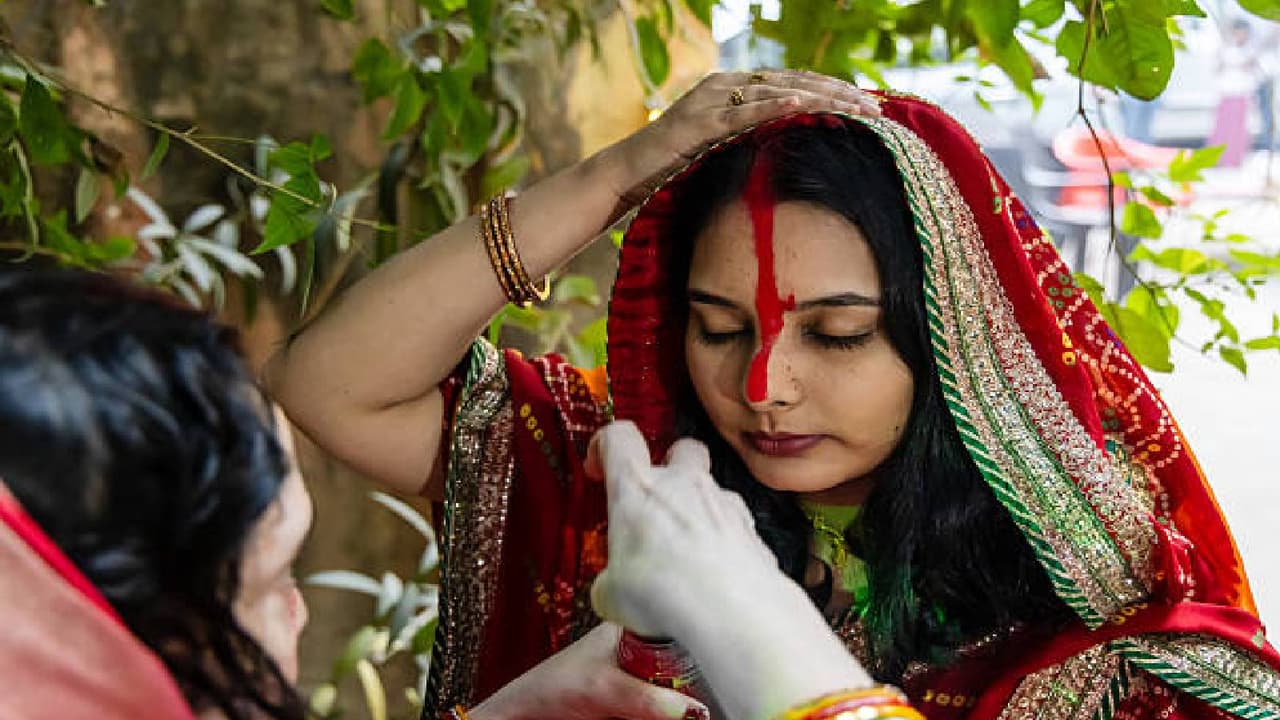During Chhath Puja, married women apply vermillion from the nose to the middle of the hair. It is not only a symbol of marital happiness but also a symbol of courage, respect and love. According to mythology, this tradition is related to the love story of Veervan and Dhirmati, let’s know…
Chhath Puja 2025: The festival of Chhath Puja is not only a symbol of devotion but also a symbol of faith, belief and trust. Celebrated every year on the Shashthi Tithi of Shukla Paksha of Kartik month, this festival starts four days in advance. This year, Shashthi Tithi of Shukla Paksha of Kartik month is falling on 28th October, hence Chhath festival will start on 25th October with Nahay-Khay. In Hindu religion, this is a festival in which the setting sun is worshipped. Chhath fast is considered both difficult and fruitful. During this time women maintain special purity and follow the traditional rituals associated with this puja. One of these is applying vermillion from the nose to the forehead. During Chhath Puja, married women apply vermillion from the nose to the middle of the hair and it is considered to have special significance.
Importance of vermilion in Hindu religion
In Hinduism, applying vermillion till the middle of the hair is considered a symbol of suhaag. It is said that married women apply vermillion to wish for their husband’s long life, good health and happy married life. It is also believed that the longer the vermilion is applied, the longer is the life of the husband.
Why is vermilion applied from the nose to the middle of the hair?
During Chhath Puja, married women apply vermillion from the nose to the middle of the hair and there is a mythological story behind it. According to legend, in a forest village there lived a young man named Veeravan, who was not only a hunter but also a great warrior. Veervan was so powerful that he could defeat even the most powerful cannibal or lion with a single blow. Outside the village, there lived a young woman named Dhirmati. Once wild animals surrounded Dhirmati and Veeravan saved her life. They started loving each other and started living together. At that time, marriage rituals were not prevalent, but there lived a person named Kalu in the forest, who did not like their meeting.
One day Veeravan and Dhirmati went far into the forest, but did not find any prey. Both of them felt thirsty and Veerwan set out in search of water. Dhirmati was waiting for him. Seeing Veerwan alone, Kalu took the opportunity and attacked him and injured him. Hearing the voice, Dheermati came running. Dheermati attacked Kalu with a sickle and Kalu threw a knife at Dheermati. But Dhirmati, with her bravery, killed Kalu by stabbing him.
After this Dhirmati hugged Veervan. Veeravan praised his wife’s bravery and lovingly placed his hand on her head. His hands were stained with blood, due to which Dhirmati’s forehead and forehead got colored. Sindoor is a symbol of bravery, while honor is worn on the nose. In such a situation, vermillion is considered a symbol of bravery, love, respect and bravery. However, the reason behind applying vermillion till the nose on Chhath festival is the wish for the long life, reputation and respect of the husband.
Disclaimer: The information contained in this article has been taken from religious texts, scholars and astrologers. We are just a medium to deliver this information to you. Users should consider this information as information only.
